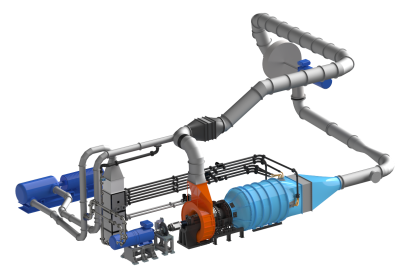AG TURBO COOREFlex-Turbo 3.1.2 – Aerothermal combuster-turbine interaction: Rotor hub side endwall
Objective of this project is the experimental investigation of the heat transfer on high pressure turbine rotor hub side endwalls. Flow mechanics and thermodynamics in that region are highly complex. Complying the requirements with respect to structural and thermal loads are crucial for the safe and durable operation of gas turbines. To fulfill the requirements extensive cooling technologies are applied. For the rotor hub side endwall this also means to avoid hot gas ingress into the cavity between stator and rotor. As all cooling flows, this sealing air is extracted from the compressor and bypasses the combustor. The so called rim seal purge flow than interacts with the main flow. Both phenomena have a negative effect on turbine efficiency.
Industry partner is Alstom Power. The project is partly funded by the Federal Republic of Germany, Minstry for Economic Affairs and Energy, within the framework of AG Turbo.
AG TURBO COOREFlex-Turbo 3.1.1 – Combuster turbine interaction: cooling efficiency and aerodynamics in the rotor tip region
This project is focusing on the effect of modern combustor technologies on aerodynamics and cooling effectiveness in the rotor tip region of the first high pressure turbine. Goal is the optimization of the combustor-turbine interface as well as a more effective use of cooling air in the tip region leading towards greater turbine efficiency.
Industry partners are Rolls-Royce Deutschland and Alstom Power. The project is partly funded by the Federal Republic of Germany, Minstry for Economic Affairs and Energy, within the framework of AG Turbo.
AG TURBO 2020 3.2.5 – Aerothermal Combustor Turbine Interaction
The content of this research project is the investigation of heat transfer and film cooling effectiveness on the hub side endwall of the nozzle guide vane, the first stator stage in the high pressure turbine. The impact of swirling combustor inflow and varied coolant injection rates is studied on a high pressure turbine blading, scaled to low Mach number conditions. In addition, film cooling effectiveness is studied on the NGV airfoil. The thermal measurement techniques infrared thermography and tracer gas measurements are used to gain the experimental data. For the project, a new turbine casing was designed, offering extensive optical and physical access to the measurement section.
Goal of the project is to achieve a better understanding of the impact of lean combustors on the design of future high pressure turbines.
Industry partners are Rolls-Royce Deutschland and Alstom Power. The project is partly funded by the Federal Republic of Germany, Minstry for Economic Affairs and Energy, within the framework of AG Turbo.
AG TURBO 2020 3.2.1A – Aerodynamic combustor turbine interaction
The project aims to investigate the effects of swirl flow typical for modern lean burn combustors on the aerodynamics of the first high pressure turbine stage. The focus is the detailed investigation of hub side endwall cooling aerodynamics in front of the first nozzle guide vane.
Within the scope of this project the measurement section is modified to allow the generation of a turbine inlet flow field which is typical for lean burn combustors. Furthermore this combustor module is equipped with varies physical and optical access to allow detailed aerodynamic measurements. The hub side endwall cooling is also realized modularly to allow geometry variation.
Industry partners is Rolls-Royce Deutschland and Alstom Power. The project is partly funded by the Federal Republic of Germany, Minstry for Economic Affairs and Energy, within the framework of AG Turbo.




